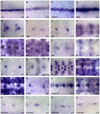Gene expression profiling of the developing Drosophila CNS midline cells
- PMID: 15501232
- PMCID: PMC2718736
- DOI: 10.1016/j.ydbio.2004.08.047
Gene expression profiling of the developing Drosophila CNS midline cells
Abstract
The Drosophila CNS midline cells constitute a specialized set of interneurons, motorneurons, and glia. The utility of the CNS midline cells as a neurogenomic system to study CNS development derives from the ability to easily identify CNS midline-expressed genes. For this study, we used a variety of sources to identify 281 putative midline-expressed genes, including enhancer trap lines, microarray data, published accounts, and the Berkeley Drosophila Genome Project (BDGP) gene expression data. For each gene, we analyzed expression at all stages of embryonic CNS development and categorized expression patterns with regard to specific midline cell types. Of the 281 candidates, we identified 224 midline-expressed genes, which include transcription factors, signaling proteins, and transposable elements. We find that 58 genes are expressed in mesectodermal precursor cells, 138 in midline primordium cells, and 143 in mature midline cells--50 in midline glia, 106 in midline neurons. Additionally, we identified 27 genes expressed in glial and mesodermal cells associated with the midline cells. This work provides the basis for future research that will generate a complete cellular and molecular map of CNS midline development, thus allowing for detailed genetic and molecular studies of neuronal and glial development and function.
Figures







Similar articles
-
Enhancer diversity and the control of a simple pattern of Drosophila CNS midline cell expression.Dev Biol. 2014 Aug 15;392(2):466-82. doi: 10.1016/j.ydbio.2014.05.011. Epub 2014 May 20. Dev Biol. 2014. PMID: 24854999 Free PMC article.
-
CNS midline cells influence the division and survival of lateral glia in the Drosophila nervous system.Genesis. 2007 May;45(5):266-74. doi: 10.1002/dvg.20283. Genesis. 2007. PMID: 17457927
-
Transcriptome analysis of Drosophila CNS midline cells reveals diverse peptidergic properties and a role for castor in neuronal differentiation.Dev Biol. 2012 Dec 1;372(1):131-42. doi: 10.1016/j.ydbio.2012.09.010. Epub 2012 Sep 23. Dev Biol. 2012. PMID: 23010511 Free PMC article.
-
Drosophila single-minded gene and the molecular genetics of CNS midline development.J Exp Zool. 1992 Mar 1;261(3):234-44. doi: 10.1002/jez.1402610303. J Exp Zool. 1992. PMID: 1629656 Review.
-
The development and function of the Drosophila CNS midline cells.Comp Biochem Physiol Comp Physiol. 1993 Mar;104(3):399-409. doi: 10.1016/0300-9629(93)90439-b. Comp Biochem Physiol Comp Physiol. 1993. PMID: 8097144 Review.
Cited by
-
A Drosophila glial cell atlas reveals a mismatch between transcriptional and morphological diversity.PLoS Biol. 2023 Oct 20;21(10):e3002328. doi: 10.1371/journal.pbio.3002328. eCollection 2023 Oct. PLoS Biol. 2023. PMID: 37862379 Free PMC article.
-
Drosophila melanogaster Zelda and Single-minded collaborate to regulate an evolutionarily dynamic CNS midline cell enhancer.Dev Biol. 2012 Jun 15;366(2):420-32. doi: 10.1016/j.ydbio.2012.04.001. Epub 2012 Apr 17. Dev Biol. 2012. PMID: 22537497 Free PMC article.
-
Proteolytic cleavage of Slit by the Tolkin protease converts an axon repulsion cue to an axon growth cue in vivo.Development. 2020 Oct 29;147(20):dev196055. doi: 10.1242/dev.196055. Development. 2020. PMID: 32994163 Free PMC article.
-
Specialized Cortex Glial Cells Accumulate Lipid Droplets in Drosophila melanogaster.PLoS One. 2015 Jul 6;10(7):e0131250. doi: 10.1371/journal.pone.0131250. eCollection 2015. PLoS One. 2015. PMID: 26148013 Free PMC article.
-
Mastermind mutations generate a unique constellation of midline cells within the Drosophila CNS.PLoS One. 2011;6(10):e26197. doi: 10.1371/journal.pone.0026197. Epub 2011 Oct 27. PLoS One. 2011. PMID: 22046261 Free PMC article.
References
-
- Araujo SJ, Tear G. Axon guidance mechanisms and molecules: lessons from invertebrates. Nat. Rev. Neurosci. 2003;4:910–922. - PubMed
-
- Ashraf SI, Ip YT. The Snail protein family regulates neuroblast expression of inscuteable and string, genes involved in asymmetry and cell division in Drosophila. Development. 2001;128:4757–4767. - PubMed
-
- Bate CM, Grunewald EB. Embryogenesis of an insect nervous system II: a second class of neuron precursor cells and the origin of the intersegmental connectives. J. Embryol. Exp. Morphol. 1981;61:317–330. - PubMed
-
- Bennetzen JL. Transposable element contributions to plant gene and genome evolution. Plant Mol. Biol. 2000;42:251–269. - PubMed
Publication types
MeSH terms
Substances
Grants and funding
LinkOut - more resources
Full Text Sources
Molecular Biology Databases

